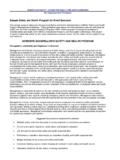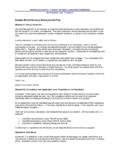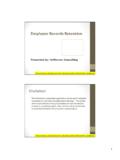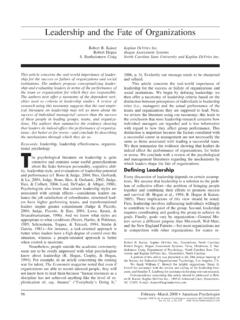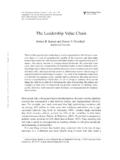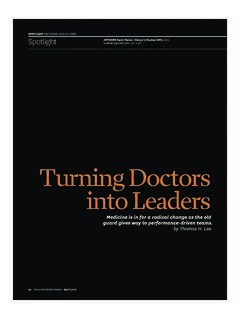Transcription of Best Practices of Safety Management
1 1 best Practices ofSafety ManagementHealth and Safety ManagementProfessional Certificate in Human ResourcesSteve Thompson, ARM, at a Glance Less then 10% of those killed in accidents occur in the workplace 30% of Americans die from cancer 40% die from heart disease and stroke (leading cause of death) 90% of middle-age Americans will develop high blood pressure 10M Americans are disabled as a result of stroke and heart disease In a recent year, workplace injury costs were $50B, but cardiovasculardisease alone was estimated at $351B Heart disease is the leading cause of premature, permanent disability inthe labor force* Statistics from the Centers for Disease Control and Prevention2*BLS Statistics Total case injuries/illness 1998-2005 Safety at a Frequency 1998 -200519981999200020012002200320042005 Exercise caution in using injury data to measure success (#8)
2 Injuries at a GlanceBetween 1998-2004 the USlost almost 20% of its manufacturing jobsand created eight million service positions3 Lesson 1 Safety leaders shape/create a Safety culture this takes precedenceover everything else Quality of leadership defines the Safety climate Policies and procedures are but not nearly as critical asa positive Safety 65 MPHO rganizations are run by the cultural rules of the workplaceLesson 2 The Hawthorne Effect or Somebody Upstairs Cares syndromeShowing people that you re concerned about them usuallyspurs them on to better job performance4 Lesson 3 Berkeley and Intracorp employee surveysPreferred source of information should be provided bysupervisorsLesson 4 Our role as Safety leader Importance of supervisorsKeep intact the dynamic relationship that exists betweenemployee and supervisor5 Lesson 5 A random and haphazard approach will lead Be onsite when employees are there - Safety is not a 9-5 job Don t assume losses are a part of doing help youremployees see this through educationSay only things that are true and say them with , , , MakingOtherDedicatedModelMotivatorExpert nessCourageousIn a survey of 54,000 US employees.
3 The top threecategories ranked among the traits employees wantedin their managers and supervisors were Integrity,Good Communicator (honesty), and that theyrespected 6 Create your own process and solution Contribute to the Safety community and industry Learn the Safety craft inside and out. Essential skills must bemastered. Be honest about your skills ask for help if necessary Give everyone else the credit and say thank you constantlyBe comfortable being a source of integrity, vision, andintuition. Seek to be producers, not consumers of these rarecommodities6 Lesson 7 Being a Safety leader and professional is a not a position Safety leadership is about being visible and viable Network among other Safety professionals, and stay engaged in thesafety communityLive the values privately and publiclyLesson 8 Do your homework Count safe activities (versus injuries)
4 As true measurement of success Exercise caution in using injury data to measure success Use wellness as an approach to safetyNever take the easy way out7 Lesson 9 Survey your employees for their opinion/perception of companysafety and your effectiveness Courage to do the right thingTake responsibility, especially for mistakesLesson 10 Plato sAllegory of the Cave Coach and mentor It s a not a sprint (allow for the process to work) Take every opportunity to put Safety out there in a positive, proactive,and visible wayTeaching is at the heart of leading8 Lesson 11 Refrain from reactive, hit and run approach Be humble and show respectMake and keep commitments to Safety and health yoursand the people you are responsible forLesson 12 Three things I will do to remain safe on the job To change behavior, reverse the role Stephen Covey We re dealing with well-meaning adults who want to do the rightthing You can encourage participative Management and employeeinvolvement.
5 But ultimately the fate and Safety of your employees isyour employees make a commitment to and understands hazards, real and and controls hazards so workers are not exposed or theexposure is core regulatory requirements (CA = IIPP) Management commitment and Safety as a company value (versus priority) and engages the well-being of employees genuine care and concernfor the workforceThe Winning Safety ModelFinal Thought Our job is to save lives, prevent injuriesand illnesses, and protect our communitiesfrom harm. For those responsible for Organizations are run by the cultural rules of the The mere act of showing people that you're concerned about them usuallyspurs them on to better job performance and integrity.
6 Also known as TheHawthorne Effect or the 'Somebody Upstairs Cares' The preferred source for information should be provided by Keep intact the dynamic relationship that exists between employee Say only things that are true and to say them with total Be comfortable with being a source of integrity, vision, and intuition. Seekto be producers, not consumers of these rare Live the values - privately and Never take the easy way Take responsibility, especially for Teaching is at the heart of leading. If you are not teaching, you are notleading11. Make and keep commitments to Safety and health yours and the peopleyou are responsible for12.
7 Have employees to make a commitment to Lessons Learned in Achieving Safety SuccessFred Rine, Founder/President of FDR Safety , Greatest Lessons: 1) People Business 2) Change thinking from HOW to WHY 3) Safety s Not About RulesDan Hopwood, Safety and Health Professional, Greatest Lessons: 1) Safety is about the Management of hazards, 2) The best of the best = PreemptiveTerry McSween of Quality Safety Edge, Greatest Lessons: 1) Clearly defined Management role, 2) Accountability at all levelsTom Drake of The Drake Group, Greatest Lessons: 1) Essential Skills must be Mastered, 2) Integrity at all times, 3)Communications EffectivenessRick Sanchez, Safety & Health Professional, Zenith Insurance, Greatest Lessons: 1) Learn from mistakes, 2) Have courage todo the right thingThomas R.
8 Krause, , Chief Executive Officer, BST, Greatest Lessons: 1) Quality of leadership defines the Safety climateand organizational cultureAubrey C. Daniels, , Aubrey Daniels International, Inc., Greatest Lessons: 1) Don t underestimate/undervalue positivereinforcement in the development of a Safety culture, 2) Behavioral technology properly understood and applied works toproduce high performance culturesRick Pollock, President, CLMI, Greatest Lessons: 1) We re dealing with well-meaning adults who want to do the right thing, 2)You can never communicate enough 3) Safety is due to the state of mind of the individual at the time of the occurrence, 4)Multiple factors make a good Safety program 5) Meaningful reward systems workSampling from Survey Participants11 Allison Fowler, Safety Professional, Inova Diagnostics, Greatest Lessons.
9 1) Be patient and flexible, 2) It s about workingwith people and being respectful of their agendas and responsibilities, 3) Be honest about your skills ask for help 4) Learnfrom your mistakes, 4) Volunteer and give back to the community, 5) Stay in close contact with your networking group, 6)Teach and be active in industry-specific organizations, 7) Be humble and show Simmons, President, Creative Safety , Greatest Lessons: 1) Managers must walk the talk show that you care, 2) Safety education, building employee relations and leadership are the building blocks, 3) Take care of your employees andsafety will followDr.
10 John Hindley, Co-Founder, BST, Greatest Lessons: 1) Strategic leadership is the most important factorElise Fischer, Safety /Vehicle/Risk Manager, Cox Communications Orange County, Greatest Lessons: 1) Listen, 2)Give what others want first, 3) Take every opportunity to put Safety out there in a positive, proactive, and visible way, 4)Don t create a separate Safety bureaucracy pair Safety with other ongoing events, etc. 5) Use reward system thateveryone can earn reward not just a few then keep it simple, 6) Use a wellness approach to Safety , 7) Express Safety asa caring profession, 8) Give everyone else the credit and say thank you constantlyJulie Gasper, Risk Manager, McBride Electric, Greatest Lessons.
